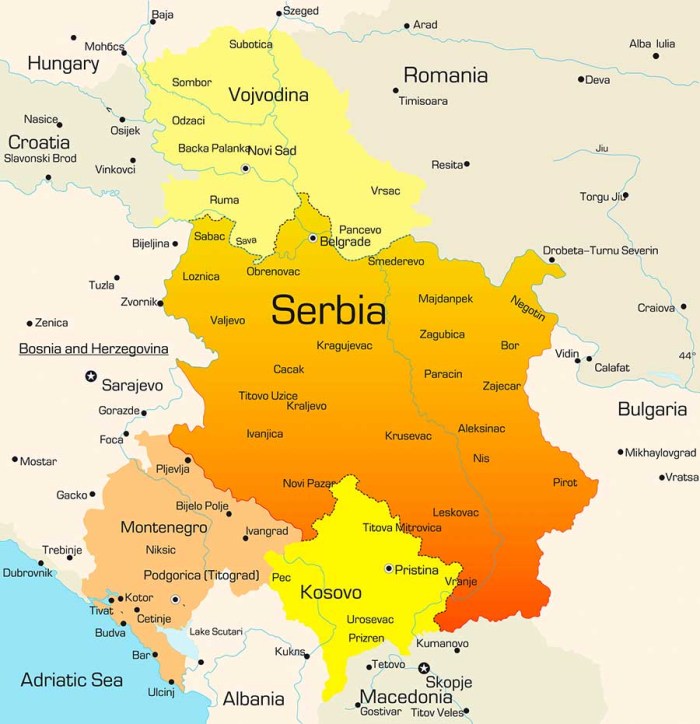China Eyes The Balkans As Wang Yi Visits Serbia
China and Russia’s growing influence could result in a diminishing of EU regional geopolitics as new trade corridors start to head East
China’s Foreign Minister Wang Yi has held meetings with Serbian Prime Minister Ana Brnabic.
The move has serious geopolitical implications as Serbia is deep in the heart of the Balkans region of Europe and surrounded to the West and East by EU member states. Yet it views Brussels with intense distrust when after the Yugoslav civil war, large parts of what were Serbian territory were carved off and divided up into new states, such as parts of Bosnia-Herzegovina and Kosovo. As a result, Serbia lost its coastline and is now landlocked.

A result of this has been a continuation of its relationship with Moscow, rather than looking to Brussels for support. That manifested itself in terms of trade with Serbia joining the Eurasian Economic Union in 2019, the only Western European country to have done so. While Serbia must now trade with its EU neighbours on less preferential terms, both Russia and China have been seeking to reconnect the country in new ways. That includes developing road and rail links through Montenegro and North Macedonia. Russia has financed and is building both road and rail links from Serbia to the Montenegrin Bar Port, whose development has been financed by China. That US$1 billion debt Montenegro borrowed from China ran into difficulties earlier in the year, with Montenegro approaching the EU for assistance. An unamused Brussels declined, with the debt subsequently being serviced by a consortium of international banks.
China meanwhile has funded and is building road and rail links from Serbia through North Macedonia, heading further south, through northern Greece to the largely China-owned Greek Port of Piraeus. These two, major projects are reconnecting Serbia to regional Port facilities. Needless to say, the Balkans view of Brussels is not close, with countries such as Albania, Montenegro, the newly named nation of North Macedonia all influenced by Serbia’s political views. That said, the relations between Russia and Albania and Montenegro are also eccentric – China here acts as the good cop go-between. Brussels meanwhile sits and fumes.
What is developing therefore in the Balkans is a jointly operated China-Russia initiative to bring this part of Europe under a more benign trade influence. In time, this may lead to other Balkan’s nations joining the EAEU as Belt and Road connectivity creates new trade routes. It should be noted that China is currently negotiating itself concerning tariff reductions, it joined the EAEU back in 2018 although until tariffs are agreed no trade impact has manifested itself. But when they do, Serbia will be a trading hub for Asian imported, duty-free products right on the borders on the Eastern EU.
At the meeting, Wang said that “Under the strategic guidance of the two heads of state, China-Serbia relations have maintained a strong development momentum, bringing tangible benefits to the two peoples and playing an important role in regional peace and stability. China-Serbia cooperation projects are carried out in various fields and have achieved positive economic and social benefits. Our relations have set a benchmark for mutually beneficial cooperation and the Belt and Road cooperation and served as a role model for the cooperation between China and Central and Eastern European countries.”
Signifying the turning of Serbia’s trade face East, Wang additionally stated that “China appreciates Serbia’s consistent and strong support for our core interests and major concerns. China cherishes Serbia’s deep friendship and prioritizes China-Serbia relations in our exchanges with Europe. China is ready to pursue common development and share prosperity with Serbia. The two sides need to promote key projects of the Belt and Road cooperation, and expand collaboration in the green economy, clean energy, efficient energy use, Internet+, cross-border e-commerce, big data, cloud computing, smart city, 5G, and other fields to provide greater impetus for sustainable development.”
Brnabic alluded to the European aspect by stating that “No matter how the international landscape evolves and what pressures we suffer, Serbia will resolutely pursue friendly policies toward China. We are ready to work with China to implement key projects of the Belt and Road cooperation, and enhance collaboration in infrastructure, the digital economy, artificial intelligence, and biotechnologies to push Serbia-China relations to a new level.”
The two agreed to develop China-Serbian cultural and trade centers in each other’s countries. China’s inroads into Europe then are also entering from the South, with Russia a key ally in this development. Over time, Serbia’s influence will probably see other regional, non-EU nations follow similar paths. Brussels meanwhile will need to be mindful of its behaviour towards Serbia’s EU neighbours Bulgaria, Croatia, Hungary, and Romania, who will be observing very closely how Serbia’s turn East works out. With already straining political relations with Brussels, the EU Balkan nations will be holding out for more EU financing. There will come a point where the EU’s powers will have to make decisions about that. China and Russia, whose influence was total over this part of Europe until the fall of the USSR, will be keeping a close watch.
Related Reading
About Us
Silk Road Briefing is written by Dezan Shira & Associates. The firm has 28 offices throughout Asia, and assists foreign investors into the region. For strategic advisory and business intelligence issues please contact the firm at silkroad@dezshira.com or visit www.dezshira.com





